If you want to explore the transformative potential of AI in finance, learning how to use ChatGPT with Python is a great place to start. This high-tech language model from OpenAI can greatly boost your performance and streamline processes like financial modeling and data analysis.
Better yet, ChatGPT’s API (Application Programming Interface) can act as a coding mentor that's available around the clock. Even without deep Python knowledge, you can use ChatGPT to write Python code in a matter of seconds – and in this blog post, we’ll teach you how.
Topics covered:
- ChatGPT vs. ChatGPT API
- Getting started with ChatGPT in Python and obtaining an OpenAI API Key
- How to use ChatGPT in Python (installation)
- Exploring the capabilities of ChatGPT in Python
- How to interact with ChatGPT programmatically
- Financial use cases of ChatGPT
- Python ChatGPT use cases in finance
ChatGPT vs. ChatGPT API: The key differences
ChatGPT and the ChatGPT API, while closely related, serve distinct functions. Both are developed by OpenAI. However, ChatGPT is the AI model that has been trained to chat, understand prompts, and generate human-like text responses. If you haven’t used it yet, you’ve definitely heard about it as its user base grew by an explosive 9,900% in the first 60 days of launch.
On the other hand, ChatGPT API allows developers to harness the power of ChatGPT in their own applications or services. Instead of having to manually input and output each interaction, you can automate and customize the process, integrating the AI's capabilities into a broader system.
You can think of ChatGPT API as the bridge connecting this tool with other software. This distinction makes the ChatGPT API especially attractive for developers and other professionals who want to embed AI capabilities within their systems.
For finance professionals who code, the ChatGPT API offers a particularly interesting opportunity. Not only can it function as an AI assistant in your financial work, but it can also serve as a coding mentor, helping you write your Python code, troubleshoot issues, and deepen your understanding of Python's vast capabilities.

Getting started with ChatGPT in Python
Don't worry if you're new to programming or Python - this is a simple guide to follow. For those of you who are seasoned Python users, you'll find this to be a breezy and straightforward process.
How to get an OpenAI API Key
To access the ChatGPT API, you’ll need to get your hands on an OpenAI API Key. Here’s how to get one:
1. First, you need to sign up on the OpenAI website and apply for an API key. To do this, select the ‘Personal’ tab. You’ll find it in the top-right section of the screen.

2. In the dropdown list, select ‘View API Keys’ and you’ll be taken to the main API keys page.
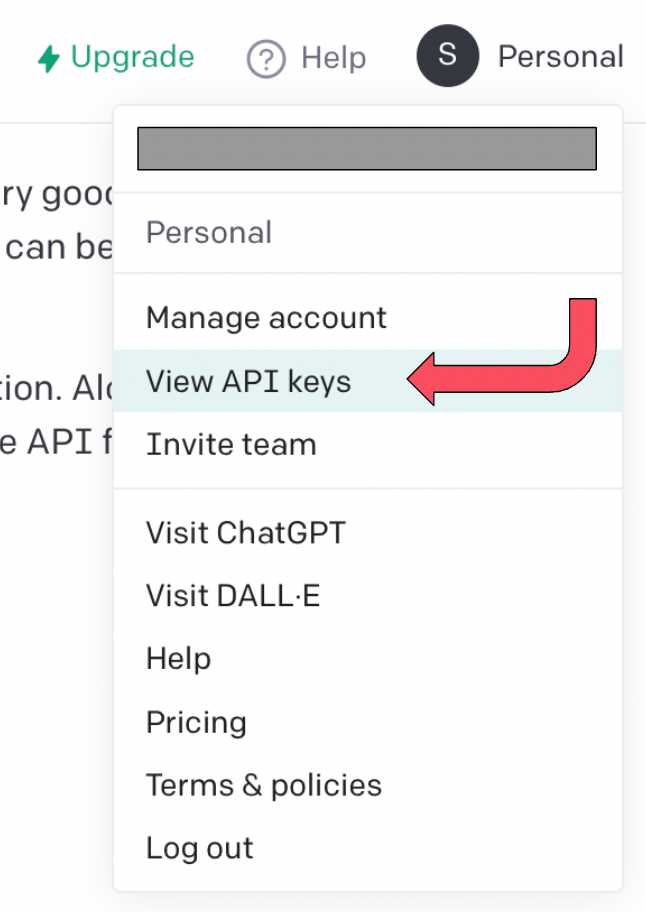
3. Select ‘Create new secret key’ to generate your API key. Take note of it because you can’t view it a second time.
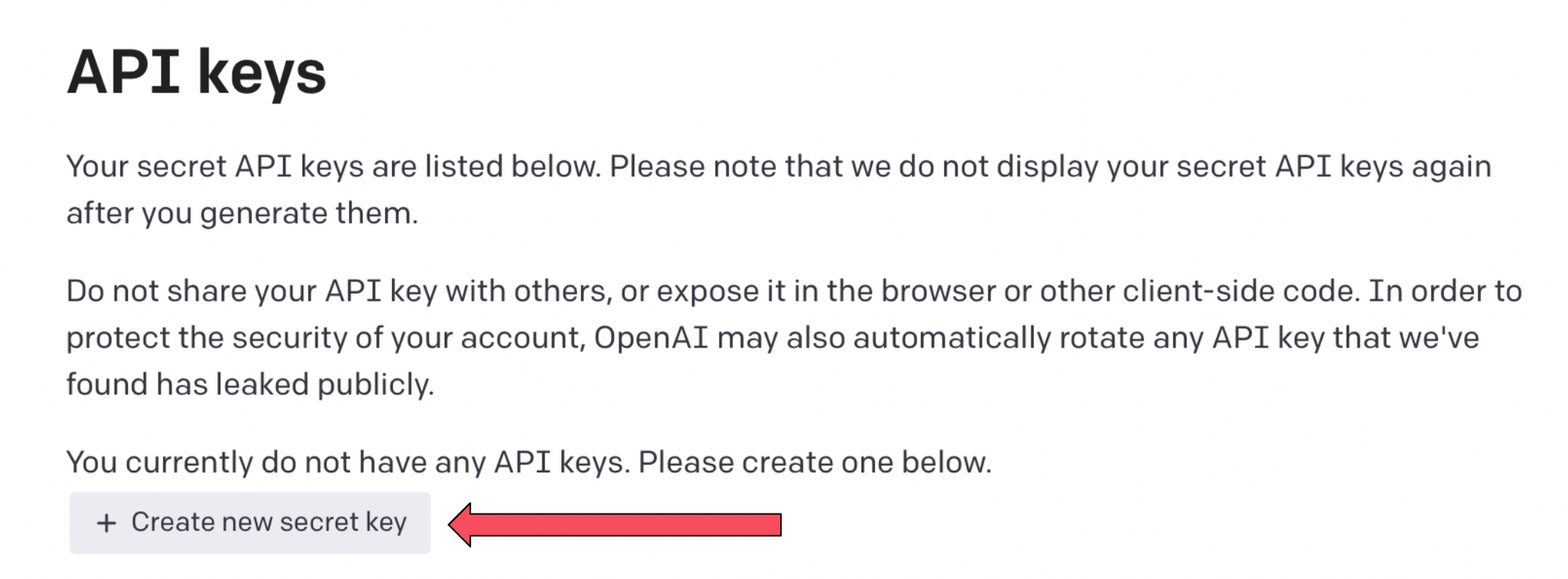
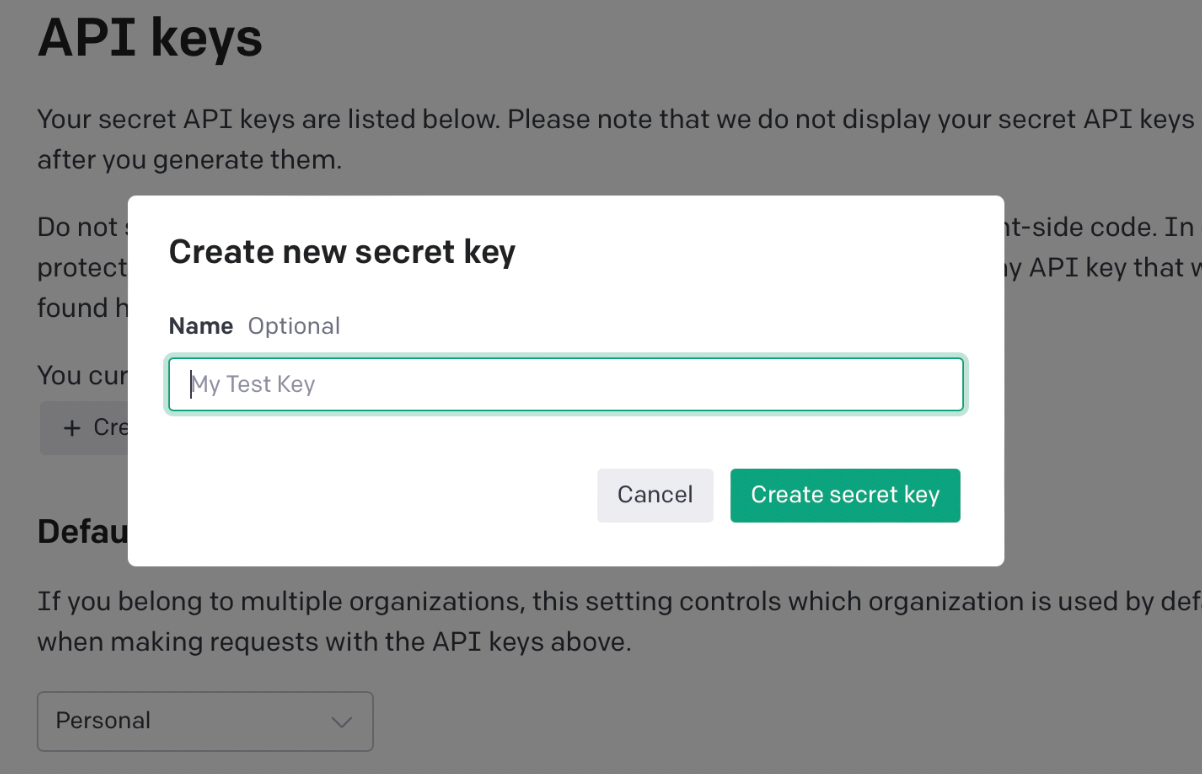
Once your application is approved, you’ll receive your unique API Key.
How to use ChatGPT in Python (installation)
Once you have an API key, you’re all set to implement the ChatGPT API in Python. This allows for seamless interaction with the ChatGPT system without having to go back and forth to the platform's site to ask questions.
By combining ChatGPT and Python, you can enable the querying and utilization of the system's features directly from your Python environment.
The instructions below are based on the assumption you’ve got your API key:
Step 1: Required Python libraries and tools
To begin, you'll need to have Python installed on your computer.
In addition to Python, you can use OpenAI's Python client library, which provides a simple interface to the ChatGPT API.
Step 2: Installing and setting up OpenAI's Python client
To install OpenAI's Python client, open your terminal (or command prompt, if you're on Windows) and type the following command:

This command uses pip, Python's package installer, to download and install the OpenAI library.
Step 3: Authenticating and making API requests
Before you can start making API requests, you'll need to authenticate with the OpenAI API. To do this, you'll need your API key from OpenAI. Once you have your key, you can set it as an environment variable in your terminal like this:

Alternatively, you can include it directly in your Python script like so:

[Note: Make sure to replace 'your-api-key' with your actual API key].
Once you've set your API key, you're ready to start making API requests. Here's a simple example of what an API request might look like:
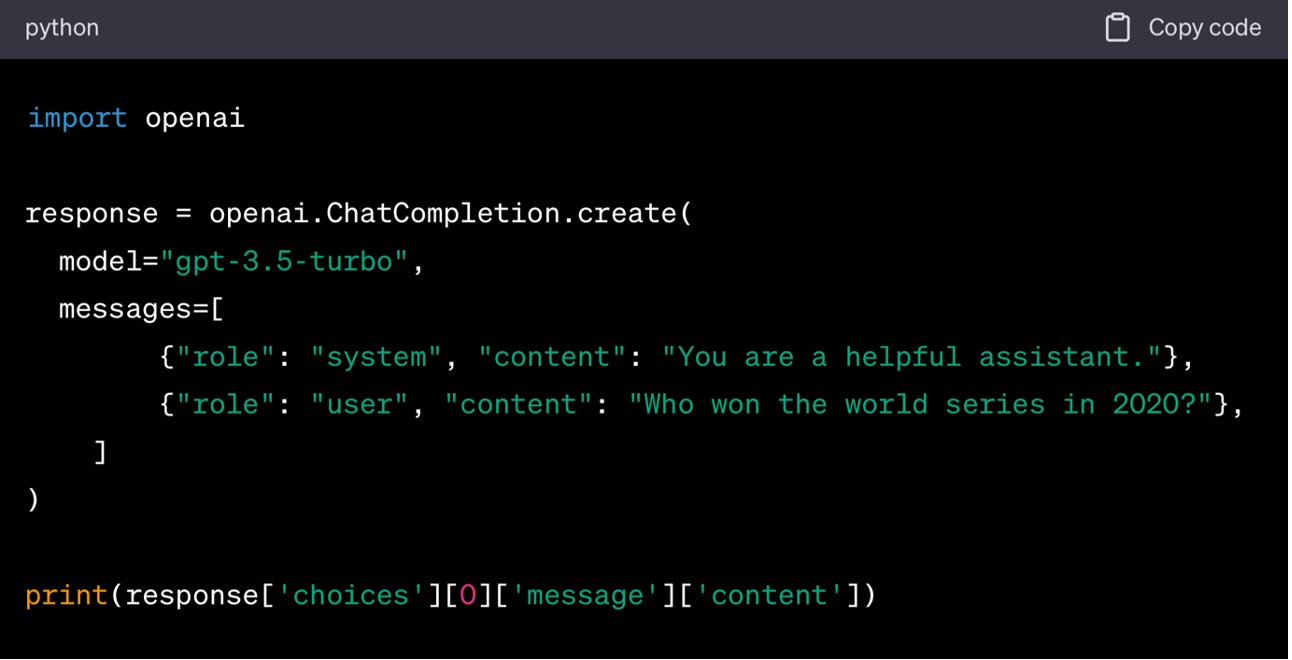
In this example, the script instructs ChatGPT to act as a helpful assistant and asks it a question. The response is then printed to the console.

Exploring the capabilities of ChatGPT in Python
Now that you’ve set up the ChatGPT API and made your first requests, it's time to delve deeper into the functionalities that this technology can offer, especially for finance professionals using Python.
Understanding Prompts, Tokens, and Models
When interacting with ChatGPT, you mainly communicate through prompts, which are essentially the input you provide to the model. For instance, if you ask the model to summarize a financial report, the report's text would be the prompt.
ChatGPT interprets your prompts as a series of tokens. A token can be as short as one character or as long as one word (e.g., 'a', 'apple'). Both the prompt and the model's response count toward the total number of tokens used.
The model you'll use in your interactions with ChatGPT refers to the specific version of the AI you're communicating with.
Understanding responses: Temperature and Max Tokens
Two important parameters significantly influence the outputs from ChatGPT and they are referred to as 'temperature' and 'max tokens'.
The 'temperature' parameter controls the randomness of the model's responses. A high temperature (close to 1) will produce more random outputs, while a low temperature (closer to 0) makes the output more deterministic and focused.
The 'max tokens' parameter controls the length of the generated response. It can be used to ensure responses don't get too lengthy. This is especially useful when analyzing financial documents in a hurry.
Handling conversational contexts
One of the exciting features of ChatGPT is its ability to handle conversational contexts. By using a series of messages instead of a single prompt, you can simulate a conversation with the model. Each message has a 'role' that can be 'system', 'user', or 'assistant', and 'content' which contains the text of the message from the role.
The 'system' role is used to set the behavior of the 'assistant'. For instance, you can tell the model that "You are an assistant that summarizes financial reports." Following this, the 'user' role can ask the assistant to perform tasks within that description, such as summarizing a quarterly earnings report.
Utilizing this conversational approach, you can build dynamic and interactive financial tools. For instance, you can develop a financial chatbot that provides explanations of complex financial terms, answers questions about specific financial events, or offers insights on financial trends.

How to interact with ChatGPT programmatically
Armed with the foundational knowledge of how ChatGPT operates and its potential capabilities, you’re now ready to level up and learn how to interact with ChatGPT programmatically. This ability to converse with the AI on your terms is what really unlocks its power, especially in the realm of finance. So, let's dive in.
Managing sessions: The concept of chat models
Chat models are a powerful feature of the ChatGPT API that allows for extended conversations. Each conversation is a session, and messages within a session are processed in the order they're received. This allows for the creation of back-and-forth dialogue, a crucial aspect of creating interactive financial applications.
Crafting system messages
System messages are typically used at the beginning of a conversation to gently instruct the assistant about its role. While not strictly required, they can help set the tone and behavior of the assistant. For example, you might start a conversation with:

This message tells the assistant to gear its responses toward financial analysis and stock predictions.
Sending user messages
User messages are where you interact with the assistant. It's as simple as dictating the role as 'user' and providing your query or instruction in the content.
For example, following the previous system message, a user message might look like this:

This will prompt the assistant to generate a response fitting the financial analysis it was primed for in the system message.
Controlling chat outputs: Setting Tokens and Temperature
To control the length and randomness of the AI's responses, you can set the 'max tokens' and 'temperature' parameters in your API call.
For example, to limit the response to 100 tokens and make it more deterministic, you could modify your API call like so:
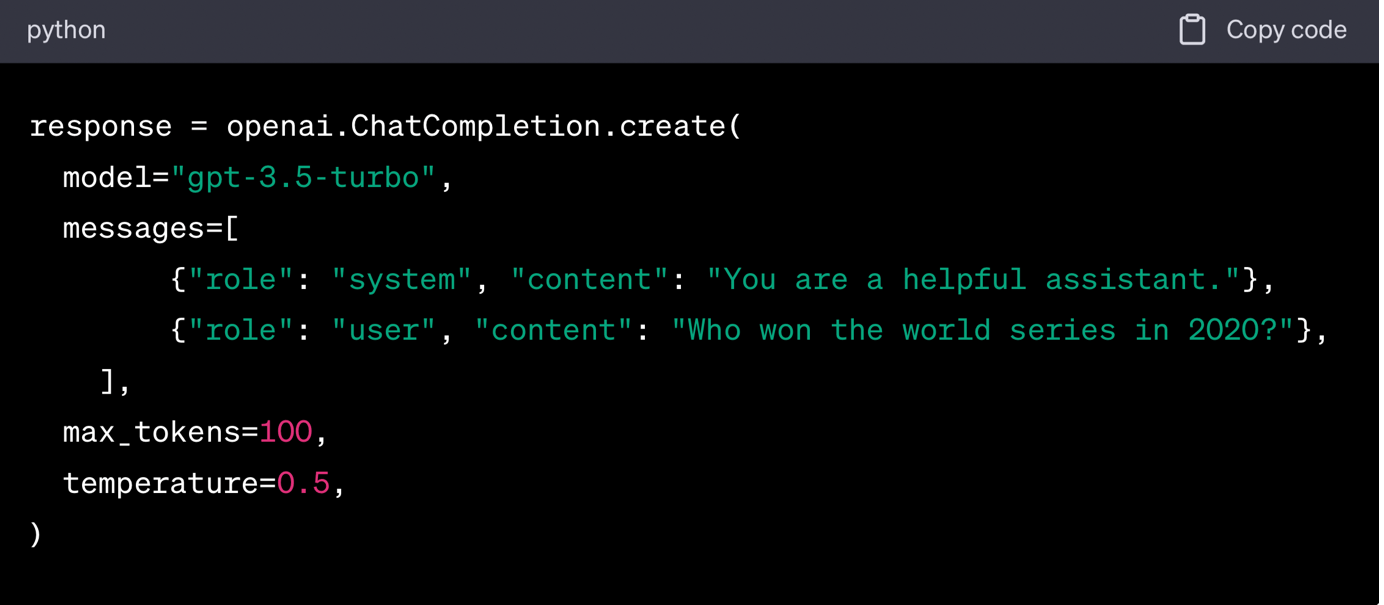
These features allow for a much more controlled and customizable interaction with the AI, allowing you to program your financial applications with precision that suits your requirements.
Financial use cases of ChatGPT
As we start to understand the mechanics of ChatGPT, the wide-ranging implications for its application in the finance industry become clear.
By combining the natural language understanding of ChatGPT with Python's powerful data-handling capabilities, we can create some truly transformative financial solutions.
Let's explore some of these potential use cases:
Creating conversational financial advisors
ChatGPT's ability to maintain context and respond to prompts makes it a great candidate for creating conversational financial advisors. These advisors can help answer customer queries on various financial products, offer personalized advice based on user inputs, or simply help users navigate the complexities of financial markets in a conversational, interactive manner.
In this use case, the ChatGPT model could simulate a financial advisor, providing users with responses to financial queries:
Prompt: As a financial advisor, what would you suggest I invest in with a budget of $10,000?
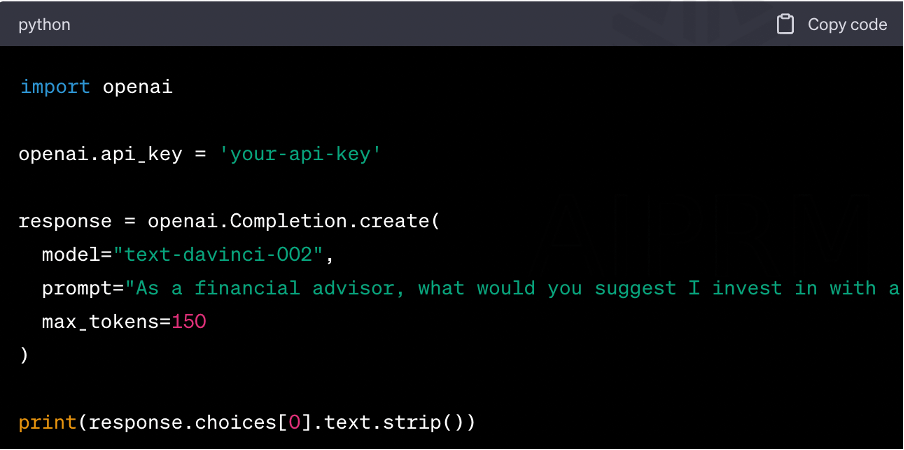
Natural language processing for financial statements
With the power of ChatGPT, extracting valuable information from financial documents like earnings reports or cash flow statements becomes a more approachable task.
You can task it to extract key financial metrics, read footnotes for any red flags, or simply transform these often dense, difficult-to-read documents into a more user-friendly format.
For processing financial statements, you might use ChatGPT to extract relevant information or translate jargon into plain English:
Prompt: Translate the following financial statement into plain English: 'The company's EBITDA increased by 10% due to aggressive cost-cutting measures and increased market share.
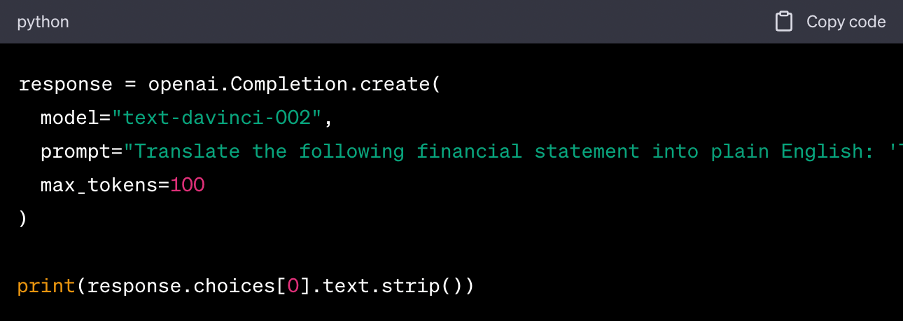
Generating summaries for complex financial reports
Finance professionals often must go through long and complex financial reports. ChatGPT can be used to generate concise summaries of these reports, saving professionals valuable time.
The model could be used to create a summary of a complex financial report, for example:
Prompt: Generate a concise summary of the following financial report: '... (report text) ...'
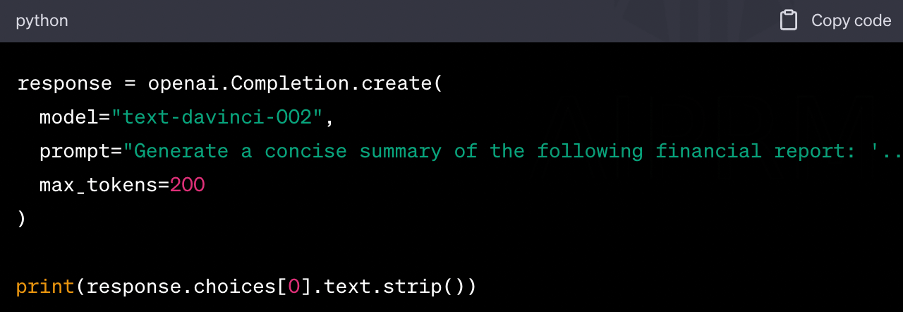
Stock market predictions and trend analysis
While no model can predict the stock market with absolute certainty, ChatGPT can be used as a tool to analyze market trends and sentiments. It can parse news articles, tweets, or other forms of public sentiment to give a broader picture of market sentiment around specific stocks, sectors, or the overall market.
It can be used to generate analysis or discuss possible scenarios based on historical trends:
Prompt: Discuss the possible trends for the tech sector in the stock market based on historical data.
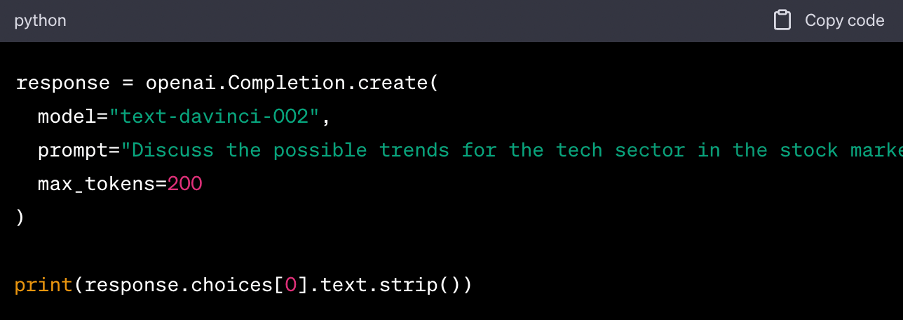
Python use cases for finance professionals
Here are some specific ChatGPT API Python examples (in finance):
Financial reporting automation
Python's ability to extract, manipulate, and analyze data makes it a perfect tool for automating financial reports. It can fetch data from various sources, perform necessary computations, and generate comprehensive reports. Combining this with ChatGPT, you could even automate the generation of written analysis to accompany your reports.
Automate spreadsheets
Python libraries like openpyxl or pandas allow for extensive manipulation and automation of spreadsheets, a staple in any finance professional's toolkit. Whether it's cleaning data, performing calculations, or creating new spreadsheets, Python can handle it. You can also leverage ChatGPT to interpret complex spreadsheet data and provide summaries or insights.
Financial analysis
Python's powerful data analysis libraries, like NumPy and pandas, can perform complex financial analysis tasks, from simple statistical analysis to more complex time-series analysis. ChatGPT can then be used to interpret and explain the results of these analyses in clear, natural language.
File management
Python can automate file management tasks like organizing documents, renaming files, and archiving old data. This can be a significant time saver for finance professionals managing large numbers of documents.
Data cleaning and validation
Python can be used to validate the integrity and accuracy of financial data. It can check for missing data, outliers, or inconsistencies in datasets, which is crucial for accurate financial analysis and reporting. Thanks to the combined pairing of ChatGPT API and Python, data cleaning is made simple.
Data visualization
Libraries like Matplotlib and Seaborn make Python a powerful tool for data visualization. You can create anything from simple bar charts to more complex financial visualizations. ChatGPT can be used to automatically generate descriptions or analyses of these visualizations.
Create PowerPoint presentations
Python has libraries like python-pptx that allow for the creation and editing of PowerPoint files. This can be used to generate presentations summarizing financial results, investment strategies, or market research. Combined with ChatGPT, you can automate the creation of presentation scripts or speaker notes.

Python Libraries for finance
Before we dive into specific libraries, let's understand what we mean by "Python libraries."
A Python library is a reusable chunk of code that you may want to include in your programs or projects to avoid creating from scratch. These libraries provide pre-written functionality that helps to execute complex tasks quickly and reduce the amount of code you need to write.
Here are some of the essential Python libraries that finance professionals might find particularly useful:
pandas
pandas is a fast, powerful, and flexible open-source data analysis and manipulation library for Python. It is perfect for handling financial data, providing data structures and functions needed to manipulate numerical tables and time-series data.
NumPy
NumPy is a library for the Python programming language, adds support for large, multi-dimensional arrays and matrices, along with a large collection of high-level mathematical functions to operate on these arrays.
Matplotlib
Matplotlib is a plotting library for Python and its numerical mathematics extension NumPy. It provides an object-oriented API for embedding plots into applications.
SciPy
SciPy is a free and open-source Python library used for scientific computing and technical computing. It contains modules for optimization, linear algebra, integration, interpolation, special functions, FFT, signal and image processing, ODE solvers, and more.
python-pptx
python-pptx is a Python library for creating and updating PowerPoint (.pptx) files. This can be particularly useful for finance professionals who often need to present their findings or analysis in the form of presentations. With python-pptx, you can create slides, add text, images, tables, graphs, and other shapes, and even manipulate the layout and design of the slides.
openpyxl
openpyxl is a Python library for reading and writing Excel 2010 xlsx/xlsm/xltx/xltm files. It is a comprehensive tool that lets you generate new Excel files, load existing ones, and access their data for further manipulation. It's particularly useful in finance for automating data extraction, transformation, and loading processes, generating reports, and performing complex calculations.
3 Tips for increased accuracy with ChatGPT Python
When it comes to interacting with ChatGPT, one of the most important aspects is crafting effective prompts. The better your prompts, the more accurate and useful the model's responses will be. This is particularly crucial for finance professionals like CFOs, financial analysts, or investment advisors, whose decision-making often hinges on accurate and precise information.
So, here are a few simple tips to help improve the accuracy of ChatGPT’s outputs:
1. Be clear and specific
One of the key things to remember when creating prompts is to be as clear and specific as possible. Ambiguity or vagueness can lead to responses that don't quite match what you were looking for. For example, instead of asking:
Tell me about Tesla’s performance.
A more specific question could be:
Can you provide a summary of Tesla's financial performance in the second quarter of 2023?
By being specific, you give ChatGPT a better chance of providing a response that meets your needs.
2. Use the right tone
The tone of your prompt can also influence the model's response. For example, if you're looking for a detailed, professional-level analysis, you might want to phrase your prompt more formally.
On the other hand, if you're looking for a simplified explanation for beginners, you might want to make that clear in your prompt. For example:
Formal, professional tone:
Provide a detailed analysis of the current bond yield curve and its implications for our investment strategy.
Simplified, beginner-friendly tone:
Could you explain in simple terms what a bond yield curve is and why it matters for our investments?
3. Experiment and iterate
Finally, one of the best ways to get better at writing prompts is to experiment and iterate. Try different phrasings and tones, and see which ones get you the results you want. If the model's response isn't what you were hoping for, try tweaking your prompt and sending it again.
To illustrate this, let's imagine a CFO is interested in an AI-generated brief about the impact of a recent Federal Reserve policy change on the company's bond portfolio. An effective prompt might look something like this:
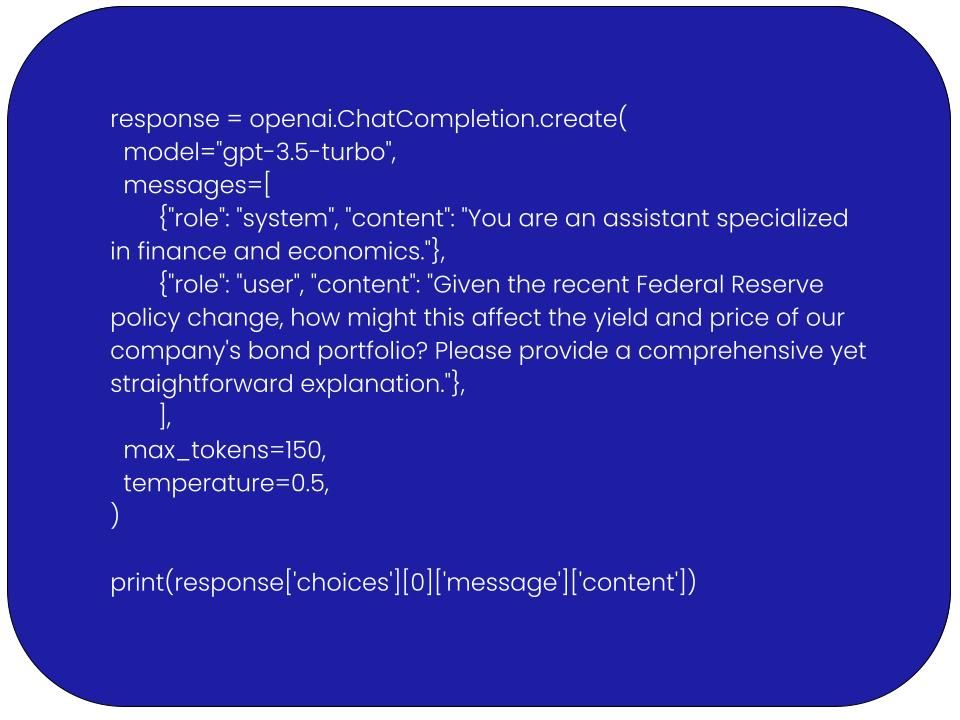
Here’s how it might look in ChatGPT Python code:
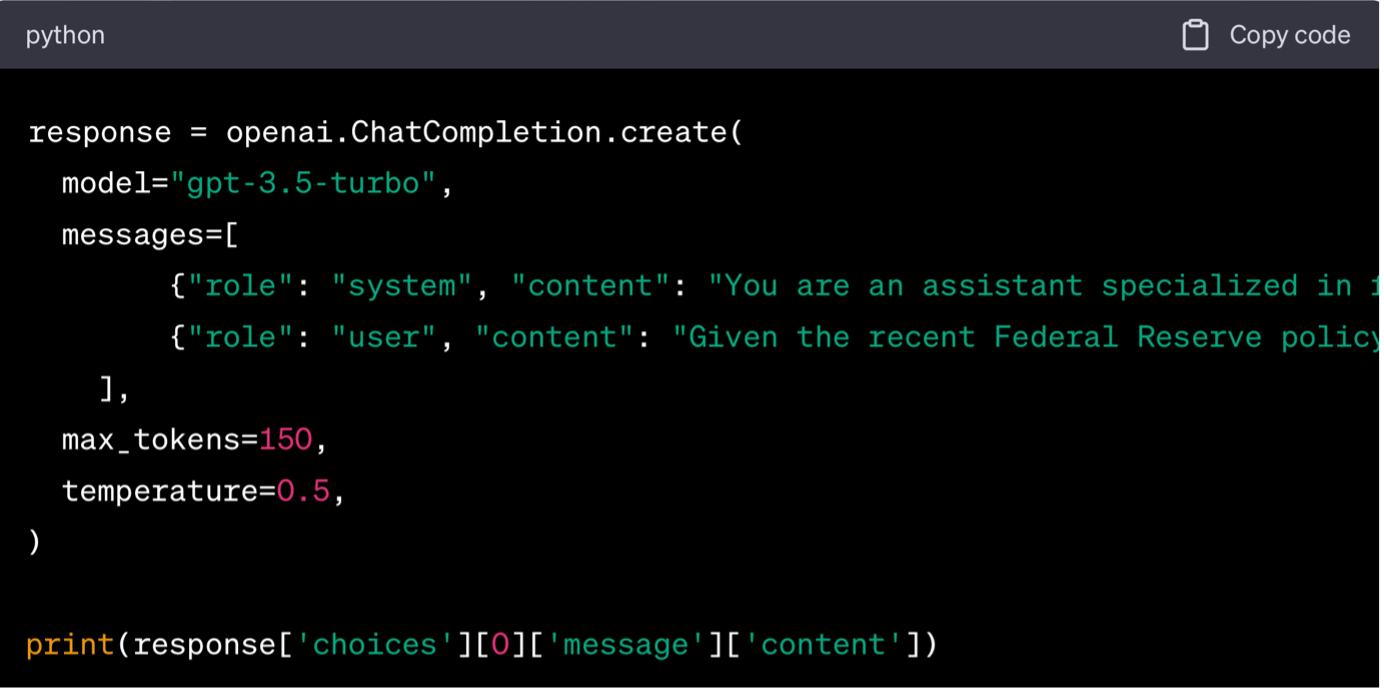
The assistant, provided with a clear, specific task and context, will then generate a response that provides the requested analysis.
FAQs: ChatGPT Python
Can I use ChatGPT for Python?
Absolutely! OpenAI provides a Python client library which you can use to interact with ChatGPT. You can install this library and use it to create a variety of interesting applications and solutions.
What are the capabilities of ChatGPT Python?
ChatGPT, when used with Python, can perform a wide range of tasks. It can generate human-like text, Python code, answer questions, create written content, translate languages, and much more.
Can ChatGPT write Python scripts?
Yes, ChatGPT can generate Python scripts based on given instructions or prompts. However, the quality and correctness of the scripts can vary and may require manual refinement.
How to interact with ChatGPT programmatically?
To interact with ChatGPT programmatically, you can use the OpenAI API. You send a list of messages to the API, and it returns a model-generated message as a response. Each message in your list should have a role (either "system", "user", or "assistant") and content (the text of the message). You'll typically start with a "system" message to set the behavior of the assistant, followed by alternating "user" and "assistant" messages. The OpenAI Python client provides an easy-to-use interface for this API.
Further reading:
Learn about Microsoft 365 Copilot and Excel with this article:
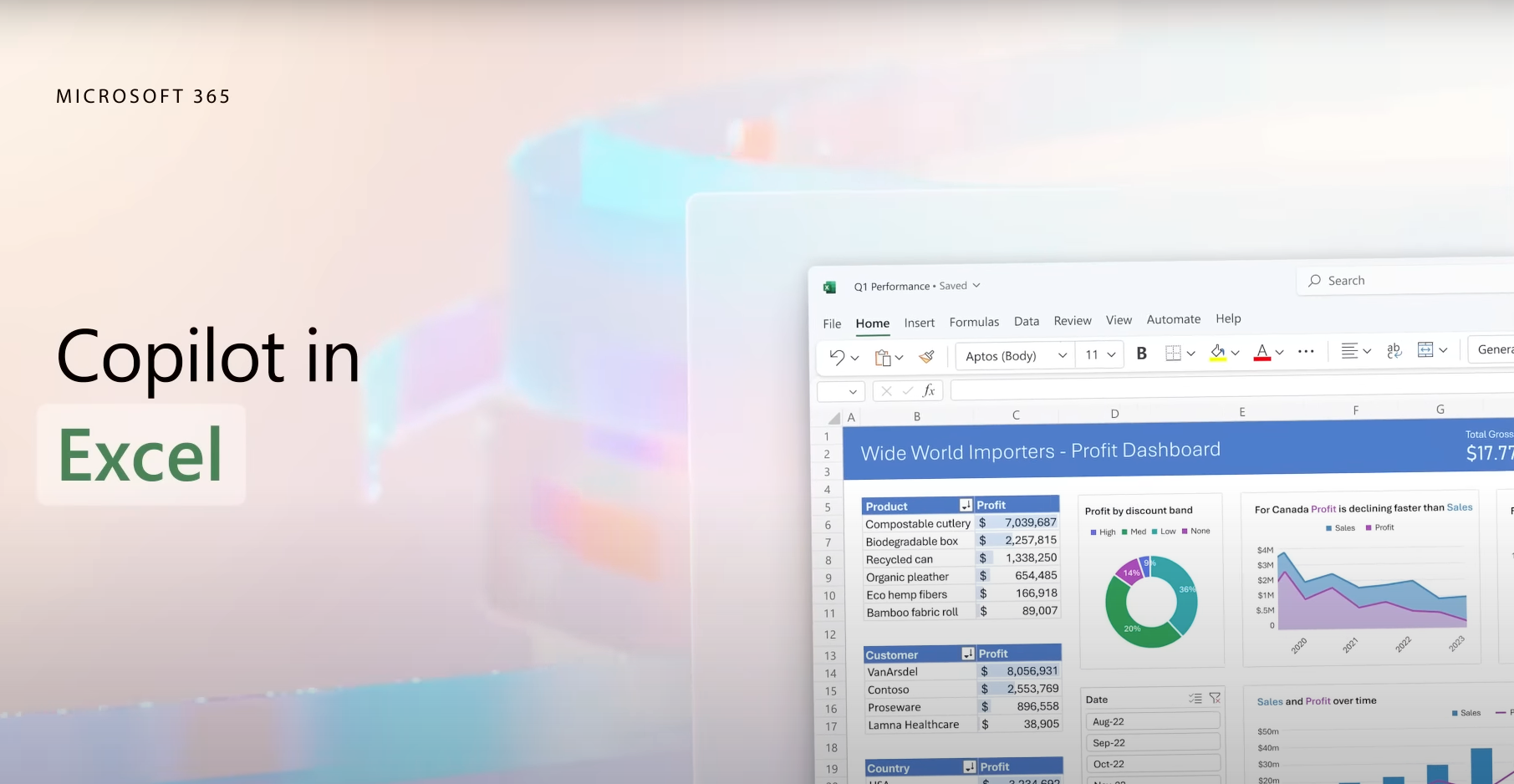
Read all about Microsoft Fabric and how you can use it with Data Factory, Synapse Real-Time Analytics, and more here:

Learn how to use ChatGPT with Excel here:

Read all about how to use Copilot with Power BI here:

And finally, discover how to use Google Bard with Excel and Google Sheets:
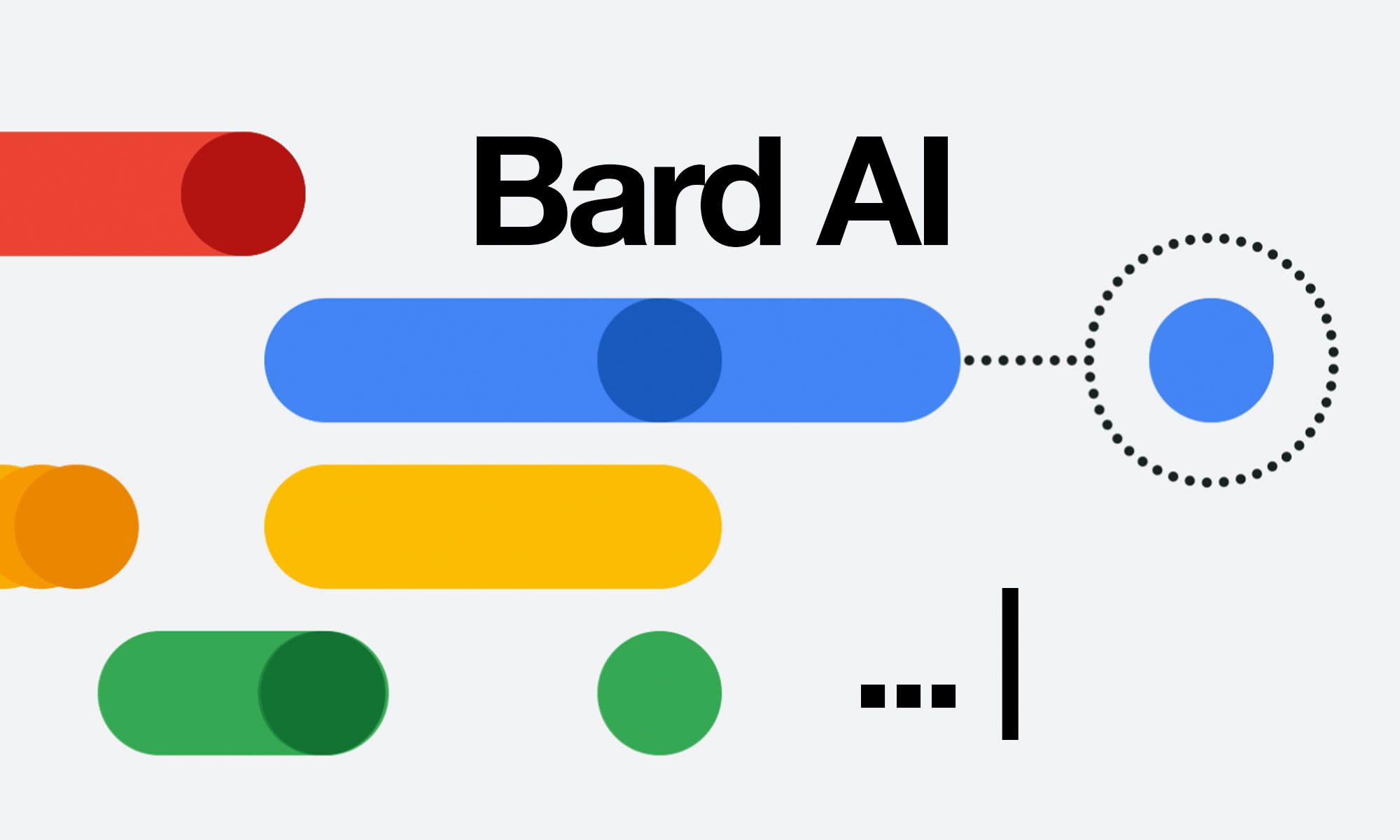
Join the Finance Alliance Slack Community
Start networking with other CFOs and finance leaders inside our free Slack community for finance professionals.
Share ideas, ask questions, discover new talent, and grow your network within one of the most engaged communities of finance professionals in the world.



 Follow us on LinkedIn
Follow us on LinkedIn




